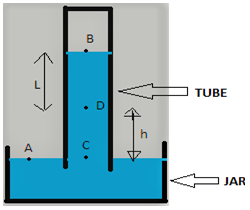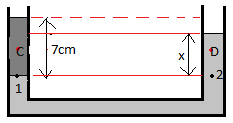This set of Class 11 Physics Chapter 10 Multiple Choice Questions & Answers (MCQs) focuses on “Mechanical Properties of Fluids”. These MCQs are created based on the latest CBSE syllabus and the NCERT curriculum, offering valuable assistance for exam preparation.
1. A nail is made pointed at its end to ensure that pressure is more for a given amount of force applied on it. True or False?
a) True
b) False
View Answer
Explanation: Pressure is defined as force per unit area. And we need more pressure to drive the nail easily into the wall. So we make the nail pointed as it has a much lesser area than a blunt end.
2. Which device is used to measure pressure?
a) Odometer
b) Barometer
c) Dynamometer
d) Hydrometer
View Answer
Explanation: Barometer is a device used to measure air pressure. Odometer is a device used to measure the distance travelled by a wheeled vehicle (it is the speed indicator in your vehicle). Dynamometer is a device used to measure torque or rpm of an engine. Hydrometer is used to measure specific gravity of liquids. Also keep in mind that the liquid used in a barometer is mercury.
3. Which of the following quantities has the same S.I. unit as that of pressure?
a) Work
b) Energy / Velocity
c) Energy / Displacement
d) mass X (velocity)2/Volume
View Answer
Explanation: The S.I. unit of pressure is N/m2.
Work has the unit of Nm.
Energy/Velocity has the unit of Nm/(m/s) = Ns.
The unit of energy/disp is Nm/m = N.
The unit of mass X (velocity) 2/Volume is same as that of energy per unit volume because mass X (velocity)2 is equal to energy,
which is in turn equal to Nm/m3 = N/m2, therefore this is the correct option.
4. Pressure is a vector quantity. True or False?
a) True
b) False
View Answer
Explanation: When we talk about pressure at a point, we say it is exerted in all directions at that point, so it is not a vector quantity. As a vector quantity should have fixed direction with magnitude.
5. Assume a force of 30 N is distributed over a surface of area 2m2 in such a way that at each point force can be considered to act at an angle of 30° to the normal at that point. What will be the value of pressure on that plane?
a) 7.5 Pa
b) 7.5\(\sqrt{3}\) Pa
c) 15 Pa
d) 15\(\sqrt{3}\) Pa
View Answer
Explanation: One important thing to keep in mind is that pressure at a point is the normal component of force per unit area, NOT total force per unit area.
So, here we will take the normal component of 30N force, i.e:
30cos(30°)=15\(\sqrt{3}\).
Press = F/A = 15\(\sqrt{3}\)/2
= 7.5\(\sqrt{3}\) Pa.
6. What is the pressure at points A, B, C & D marked in the given mercury barometer? Assume that you have used a tube of length greater than 76cm and then filled it completely with mercury and then inverted into a jar. Let P0 be atmospheric pressure, g be acceleration due to gravity and ρ be the density of mercury.

a) PA = P0, PB = P0, PC = PA, PD = P0+ ρgL
b) PA = 0, PB = P0, PC = ρg(h+L), PD = P0– ρgh
c) PA = 0, PB = 0, PC = P0, PD = P0+ ρgL
d) PA = P0, PB = 0, PC = P0, PD = ρgL
View Answer
Explanation: The assumption given in the question is to ensure that when the tub is inverted into the jar, the pressure on the top of the tube stays zero, in other words, vacuum gets created.
Point A is exposed to atmosphere, so PA = P0.
Point B is the top layer exposed to vacuum so PB = 0.
Point C is on the same level as that of A, and the fluid is stationary, so PC = PA = P0. Point D is at a depth L below point B so PD = 0 + ρgL.
∴ the correct option is PA = P0, PB = 0, PC = P0, PD = ρgL.
Also note that we can write PD as P0 – ρgh and PC as ρg(L+h).
7. A car containing a beaker of water is moving horizontally on a level road. Consider two points, A & B, inside the water such that they are on the same horizontal level and are separated by a distance L. Which of the following options is correct regarding the pressure differences between those two points?
a) If car is accelerating with acceleration a, PA – PB = ρgL
b) If car is accelerating with acceleration a, PA – PB = 0
c) If car is moving with constant velocity, PA – PB = 0
d) If car is moving with constant acceleration a, PA – PB = ρ (g+a)L
View Answer
Explanation: When the car is moving with constant velocity, points on the same horizontal level will have the same pressure.
So, PA – PB = 0.
When the car moves with constant acceleration the pressure difference between those two points will be ρaL,
as the pressure difference will be responsible for providing acceleration to the small fluid column of volume L*dA between points A & B
(where dA is an area of small element that we think of).
8. Fluid C has a relative density of 10, while fluid D has a relative density of 15. If the height of liquid C is 7cm, what will be the difference in heights of liquid D in the two tubes? In the diagram point 1 is in liquid D just after the end of liquid C.

a) 5cm
b) 10.5cm
c) 15cm
d) 4.67cm
View Answer
Explanation: Pressure at points marked 1 & 2 is the same.
Pressure at point 1 is (7ρ1g).
Pressure at point 2 is (xρ2g).
We know P1 = P2;
∴ xρ2 = 7ρ1.
&rho1 = 10, ρ2 = 15
∴ x = 7*10/15 = 4.67cm.
More MCQs on Class 11 Physics Chapter 10:
- Chapter 10 – Mechanical Properties of Fluids MCQ (Set 2)
- Chapter 10 – Mechanical Properties of Fluids MCQ (Set 3)
- Chapter 10 – Mechanical Properties of Fluids MCQ (Set 4)
- Chapter 10 – Mechanical Properties of Fluids MCQ (Set 5)
- Chapter 10 – Mechanical Properties of Fluids MCQ (Set 6)
To practice all chapters and topics of class 11 Physics, here is complete set of 1000+ Multiple Choice Questions and Answers.
If you find a mistake in question / option / answer, kindly take a screenshot and email to [email protected]
- Practice Class 11 - Mathematics MCQs
- Check Class 11 - Physics Books
- Practice Class 12 - Physics MCQs
- Practice Class 11 - Chemistry MCQs
- Practice Class 11 - Biology MCQs
